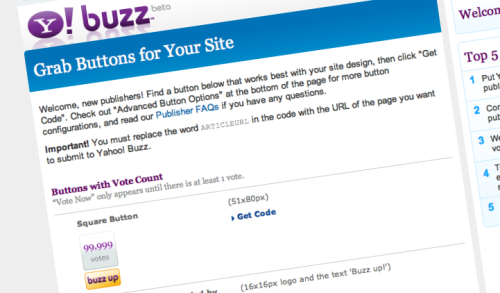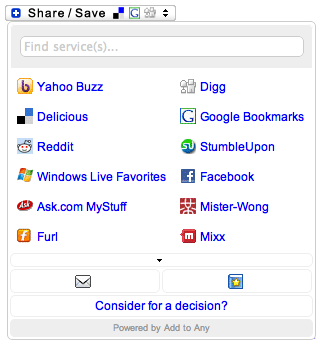
Since its official launch, the service has proven that it is able to drive pretty decent amounts of traffic to sites, as long as their content is interesting and relevant, much like Digg (except without as much discrimination against content that shouldn't make it to the front page). There have been some recognized negative aspects of the service, as I found when I tried integrating the service on different blogging platforms.
Yahoo! Buzz does something that no other service can - place a link to your article (possibly redirecting to the Buzz page before your site) on the Yahoo! home page, within the four plus featured articles. In addition, it will appear on the Buzz homepage, starred, and in the content/image slider at the top of the page.
As an example of the traffic you can receive, Read Write Web received more than 45,000 page views within a three and a half hour period (not when most people were online, too), plus that post received more than 160 comments, versus the twenty-two the site saw on the post where they exposed the traffic figures. Some particular ranking services (comScore, for example), have found, at least in May, that the Buzz service grew to a larger size than Digg.
In addition, if people select the widget and place it on their website with the category that your blog is in, and you happen to be featured, the post will potentially be exposed to even more visitors.
In this post, I don't want to necessarily provide information on how to integrate the submit buttons onto your website, but resources that will help you do so.
The "general" buttons that are found on the Yahoo! Buzz website were created for adding to individual pages or posts - adding a great deal of time to your already busy posting schedule! Plus, not all links that bloggers wanted to feature on their blog were included in the set available. The steps may appear complicated to people who have not edited their code but want a particular style of image/link on their website.
Listed below are several different versions for integrating the widget into your blog.
First, you can use the Add to Any widget (plugin and embedable) for WordPress, Widgetbox, FeedFlare, Joomla, Blogger (advanced and basic/widget versions), TypePad (advanced and basic/widget versions), Tumblr, Drupal, and other basic websites. This may be the best option, as it is one of the first and only "add to any social networking service plugins" that allows you to integrate the Yahoo! Buzz link without editing the code. In addition, this service allows you to add additional services right from the editing panel should you need to add another service.

The ShareThis, AddThis, iBegin Share, and others do not include the Yahoo! Buzz widget by default.
An additional alternative for WordPress users is the Sociable Plugin, which adds buttons (links) to the bottom of each post. It does require editing and adding an image to the Yahoo! Buzz page, but is easier than other plugins that do not have the plugin already added.
A plugin, WPBuzz, created by Travis Johnson, allows you to automatically add a special button (similar to the Digg version) into each post. It requires less than five steps to use the plugin (download, extract, upload, activate, then set the settings).
WordPress users can (manually) add the widget, by using the tag on this page (in the comments)
ARTICLEURL, provided their instructions:Important! You must replace the word
ARTICLEURL in the code with the URL of the page you want to submit to Yahoo! Buzz.For Blogger/BlogSpot users, follow the following tips/resources to add the link to your site.
ThemeLib has created a tutorial to add the button to your website. It involves editing the HTML/layout of your blog, but is fairly simple if you know how to do this. Visitors will then be able to vote up each of your posts.
For any of the blogging services, you can use the buttons that Yahoo has provided, but you'll need to input the URL of each post into the script and in each post. Placing the code in the sidebar will place a link to add your entire site (the main URL) to the service.
If you have any other suggestions as to adding the code to your website for proper usage, place leave the recommendation in the comments.
1 comment:
Thanks for writing a post on this topic. Very useful info
regards,
Blogger Accessories
Post a Comment